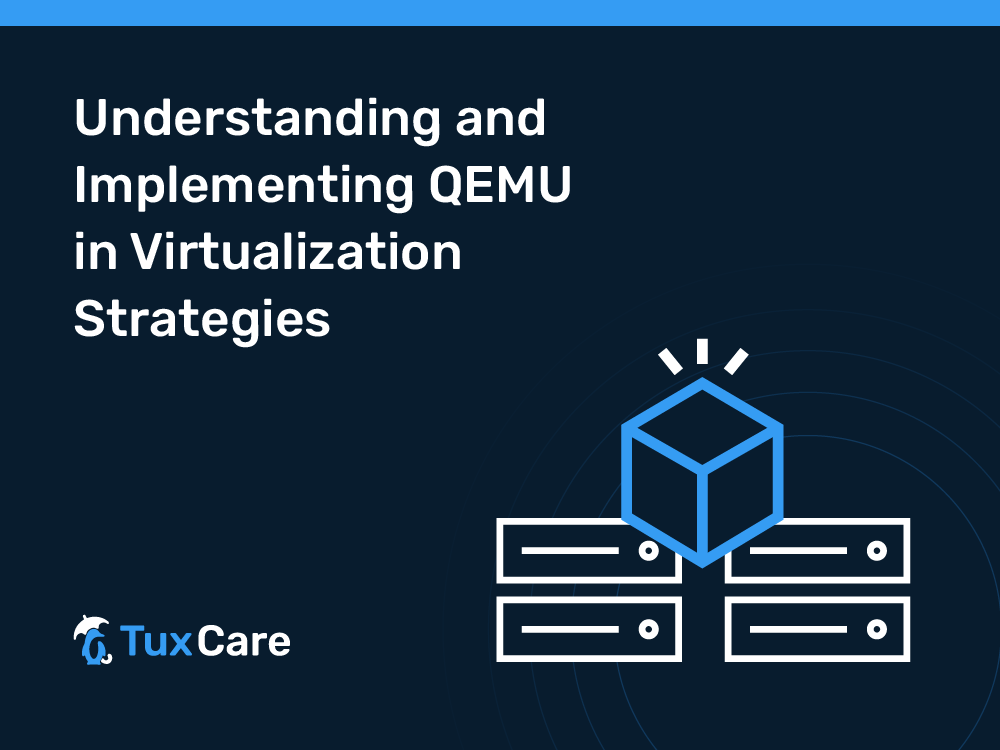Understanding and Implementing QEMU in Virtualization Strategies
- QEMU is a popular open-source machine emulator.
- QEMU supports hardware virtualization extensions (Intel VT-x and AMD-V).
- QEMUCare offers a live patching solution for QEMU-based virtualization systems.
Virtualization has now emerged as the pillar of modern IT infrastructure, empowering organizations to achieve unprecedented levels of flexibility, scalability, and resource efficiency. In this context, QEMU (Quick EMUlator), a versatile and powerful open-source emulator, has become a cornerstone of virtualization strategies. In this comprehensive guide, we will delve into the role of QEMU in virtualization strategies, shedding light on its features and offering practical insights for effective implementation.
An Overview of QEMU
QEMU is a rapidly developing emulator that makes hardware virtualization easier. It emulates an entire computer system, allowing users to run guest operating systems on a host system, even if the guest OS architecture differs from the host. QEMU supports many architectures, such as x86, ARM, and PowerPC.
Key Features of QEMU in Virtualization
Cross-Architecture Emulation: Guest operating systems can run on hosts with different underlying architectures thanks to QEMU’s ability to emulate various architectures.
Hardware Virtualization Support: QEMU can leverage hardware virtualization extensions, such as Intel VT-x and AMD-V, enhancing performance by offloading specific tasks to the underlying hardware.
User and System Emulation Modes: QEMU functions in both system and user modes. It emulates individual binaries in user mode and an entire system, including the kernel, in system mode.
Snapshot Support: Users can take snapshots and record the state of a virtual machine at a particular moment in time. This feature makes testing and development easier by offering a simple method for rolling back to a previous state.
Live Migration: With live migration enabled by QEMU, a virtual machine can be moved seamlessly from one host to another without significant downtime.
Disk Image Format: QEMU supports various disk image formats, such as Qcow2, VMDK, and raw, which gives users the freedom to employ a variety of storage options. It also provides a qemu-img convert command that enables the conversion between multiple image formats.
Networking Capabilities: Users can set up networking interfaces for communication between host and guest systems, as well as between multiple guest systems.
Role of QEMU in Virtualization Strategies
Development and Testing
QEMU offers a platform for developing and testing software on several architectures without requiring dedicated hardware. It helps streamline the development process and guarantee software compatibility across a range of systems.
Cross-Platform Development
Developers can test their software on various architectures to ensure it runs smoothly and is compatible with different systems. Cross-platform testing is essential in today’s diverse computing environment, which makes QEMU an incredibly flexible tool for system administrators, virtualization experts, and developers.
Embedded Systems Development
When dealing with embedded devices, developers can greatly benefit from QEMU. Without the need for physical hardware, developers can create and test software for embedded systems using QEMU.
Server Virtualization
QEMU and KVM are frequently used together in server virtualization scenarios. While KVM provides hardware-assisted virtualization, QEMU takes care of management and emulation aspects. This combination provides a powerful solution for setting up and managing virtualized servers.
Tips for Implementing QEMU in Virtualization
Using KVM Acceleration
KVM acceleration can enhance performance if your host system supports hardware virtualization. For this, you will need to enable virtualization extensions like Intel VT-x or AMD-V.
Optimizing Disk Images
Choose an appropriate disk image format, such as Qcow2, and use sparse images to optimize storage space. Disk image management is necessary for both performance and resource utilization.
Security Practices
Consider implementing strong security measures, especially if virtual machines are being exposed to outside networks. To reduce potential threats, use firewall rules, keep both the host and guest systems up to date, and adhere to security best practices, including vulnerability patching.
You can utilize TuxCare’s QEMUCare live patching solution for effective patch management. QEMUCare automatically applies security updates to your virtualization systems without requiring a reboot or migration, ensuring a 100% uptime of your machines with zero disruptions.
QEMUCare goes beyond offering valuable assistance in meeting compliance standards. If your operations involve compliance requirements related to security patching deployment or reporting, achieving these standards has become easier with Live Patching.
Snapshot Management
Consider using QEMU’s snapshot feature to create checkpoints for your virtual machines. This makes it easier to roll back to a known state and comes in handy for development and testing workflows.
Monitoring and Performance Tuning
You can use monitoring tools to track the performance of your virtual machines. To keep tabs on your virtual machines’ performance, use monitoring tools. Depending on the workload, modify parameters like CPU and RAM allocation to maximize efficiency and resource utilization.
Final Thoughts
QEMU in virtualization emerged as a powerful and flexible tool with many features that cater to various use cases. Whether you’re a developer, system administrator, or involved in server virtualization, understanding and effectively implementing QEMU can significantly enhance your virtualization strategies. By following best practices, optimizing configurations, and staying active in the community, you can harness the full potential of QEMU in building a robust and efficient virtualized environment.
Speak to a TuxCare virtualization expert to get started with QEMUCare for your virtualization systems.



 Documentation
Documentation Login
Login




